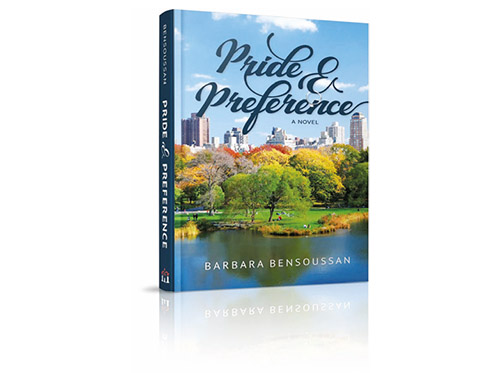
Reviewing: “Pride and Preference” by Barbara Bensoussan. Menucha Publishers. 2020. English. Hardcover. 250 pages. ISBN-13: 978-1614658337.
Jane Austen’s classic novel “Pride and Prejudice” is so universally beloved that it has given rise to countless films, spinoffs, prequels and sequels. Hence, it was perhaps only a matter of time before an Orthodox writer decided to take her own stab at transposing the novel’s plot into a contemporary Jewish setting.
In “Pride and Preference,” published by Menucha Publishers, author Barbara Bensoussan takes Austen’s themes of snobbery, money, social class and the longings of young women to find a husband and neatly slips them into the 21st-century shidduch scene, all with a generous dose of warmth and humor. (Readers may recognize Bensoussan’s name from the many articles she has written for Jewish publications as well as her previous books, “A New Song” and “The Well-Spiced Life.”)
Shidduchim are on everyone’s minds these days, and as the author avows in her afterword, “It was when my own children started shidduchim that the idea to create a Jewish version of ‘Pride and Prejudice’ took root… It is, after all, a story about shidduchim, mone, and lashon hara.” The very things that hamper Austen’s protagonists in their search for a spouse—lack of money, embarrassing relatives, social snobbery—often hamper frum young people as well in a system in which being able to offer support and having a spotless reputation count heavily.
“Pride and Preference” is the story of the Bennets of Flatbush, a respectable but decidedly unwealthy family in which the father is a menahel and the mother a Bais Yaakov secretary. With five daughters to marry and little money to offer for support, their daughters’ prospects of landing a worthy shidduch appear grim. To make matters worse, the middle daughter has a propensity for pushing the boundaries of appropriate high school behavior—she tends to disappear only to be found hanging out in pizza shops at late hours, and she sample too many cocktails at weddings—which risks sullying the family’s otherwise upstanding reputation. Austen’s wild, reckless Lydia finds her frum equivalent in Liora, who’s clearly a “kid at risk.”
It’s obvious that Bensoussan had fun transforming the English names chosen by Austen into Jewish equivalents: Jane becomes Shaina, as sweet and giving as Austen’s character, while Elizabeth becomes Aliza, possessed of a sharp mind and tongue like Austen’s heroine. The dour Mary becomes Miri, a young woman who comes home from seminary taking herself a bit too seriously; the youngest, Katy, is Kaylie.
Austen’s Mr. and Mrs. Bennett become Rabbi and Mrs. Bennet. He’s a seasoned menahel who nevertheless has little patience for the antics and shidduch dramas of his daughters, while his wife is a nervous, simple-minded Jewish mother who only wants to see her daughters married.
Bensoussan admits that it wasn’t easy fitting the original plot of “Pride and Prejudice” into the limitations of frum literature. All the encounters between young men and women had to happen by accident, in the presence of chaperones, or on a formally arranged date. She was obliged to invent a shadchan, the wily, delightful Mrs. Lowy, to serve as a go-between. The tasks of both breaking off and saving shidduchim fall into her lap, and it is only through her deft handling of challenging situations that the shidduchim succeed (and she’s able to earn the money she needs to fly to Israel for her new grandchild).
The plight of older singles is sympathetically rendered in the story of Aliza’s friend, 28-year-old Charna, who is described as “particularly tall for a girl, and too bright and thoughtful for many of the young men she’d been introduced to.” When Charna gets engaged to Aliza’s pedantic if well-meaning cousin Zelig, Aliza is appalled. But Charna tells her practically: “I’ll be turning 29 this summer. I’m not looking for fireworks at this stage! I’m tired of being redt to men who are divorced or have issues or who have started working and lost their bren for learning.”
Of course, it is Aliza’s shidduch with Danny that is the center of the novel. Her dislike of him begins with an overheard remark she misinterprets as snobbish, and things go downhill from there. Assuming his family’s money means he must be a terrible snob, and then believing he broke up her sister’s shidduch, Aliza rejects him when he shows interest. Their path to the chuppah is fraught with numerous detours and glitches, including the rich, pompous relative who covets Danny for her own daughter.
Readers who aren’t familiar with “Pride and Prejudice” will enjoy “Pride and Preference” as an entertaining, often hilarious shidduch story. But those who love Austen’s original classic will revel in the way “Pride and Preference” so cleverly fits her themes and relationships into the frum world and shidduch system we all know.
By Rebecca Karp









